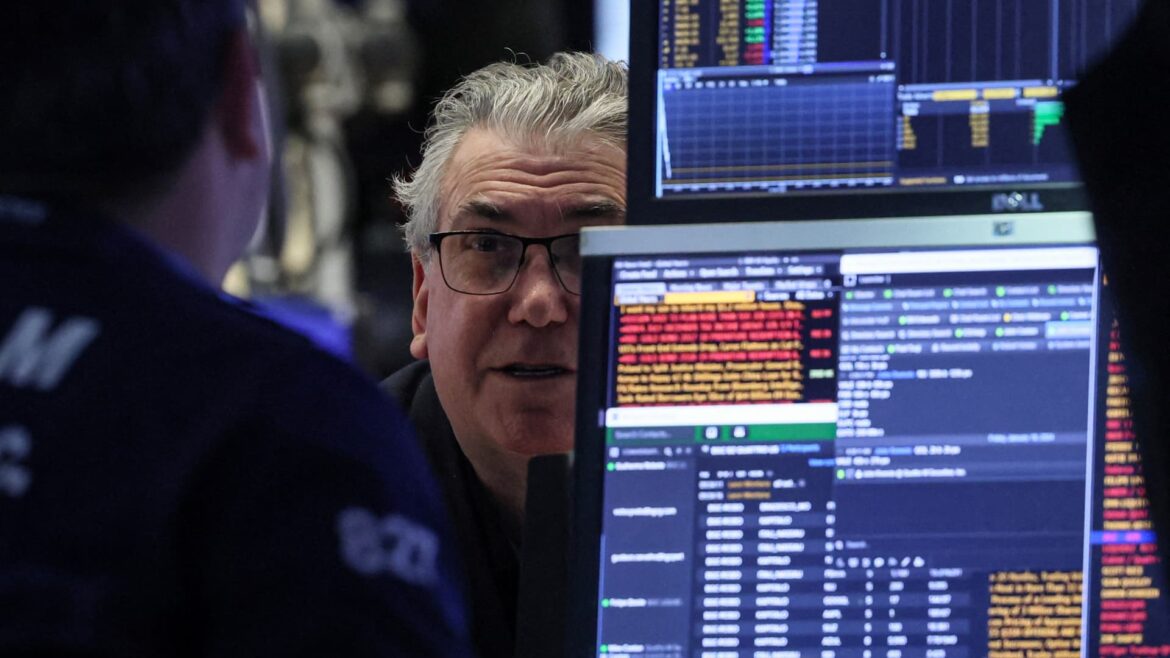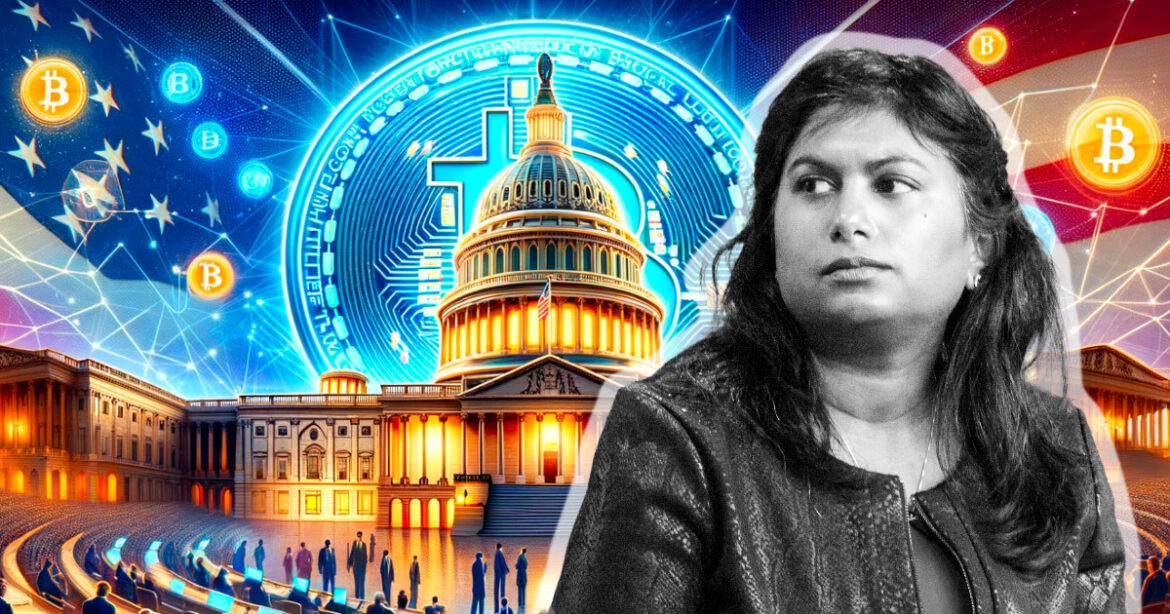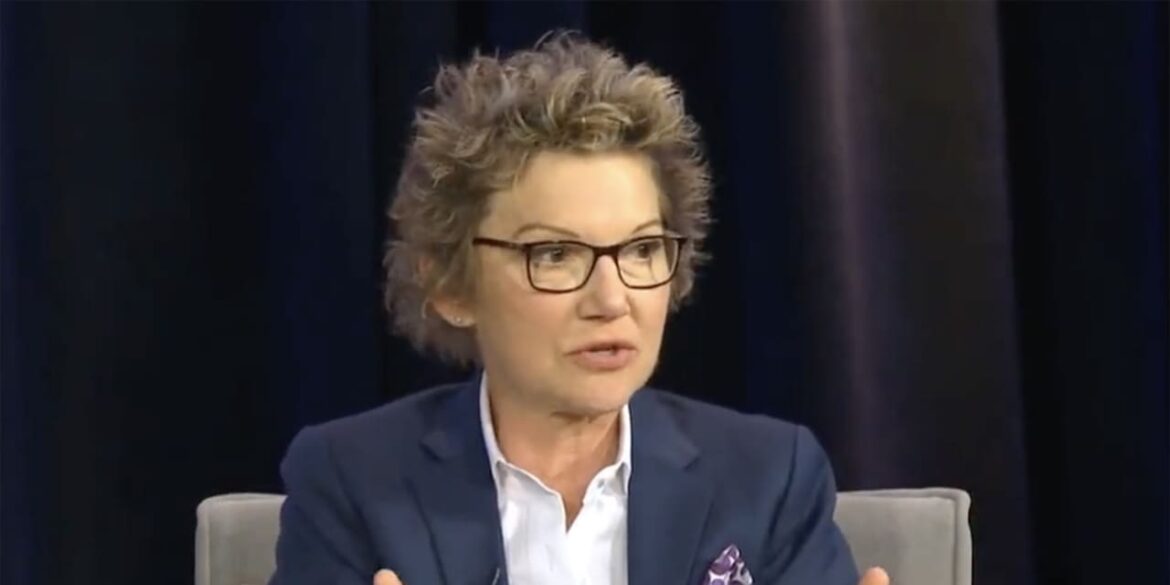
“Should I pay off the reverse mortgage and risk losing the money if she ends up spending years in a home?”
Source link
policy
Two important events this week could determine the future of Fed rate policy
Traders work on the floor at the New York Stock Exchange (NYSE) in New York City, U.S., January 19, 2024.
Brendan Mcdermid | Reuters
Markets have become less convinced that the Federal Reserve is ready to press the button on interest rate cuts, an issue that cuts at the heart of where the economy and stocks are headed.
Two big economic reports coming up this week could go a long way toward determining at least which way the central bank policymakers could lean — and how markets might react to a turn in monetary policy.
Investors will get their first look at the broad picture of fourth-quarter economic growth for 2023 when the Commerce Department releases its initial gross domestic product estimate on Thursday. Economists surveyed by Dow Jones are expecting the total of all goods and services produced in the U.S. economy to have grown at a 1.7% pace for the final three months of 2023, which would be the slowest since the 0.6% decline in Q2 of 2022.
A day later, the Commerce Department will release the December reading on the personal consumption expenditures price index, a favorite Fed inflation gauge. The consensus expectation for core PCE prices, which exclude the volatile food and energy components, is 0.2% growth for the month and 3% for the full year.
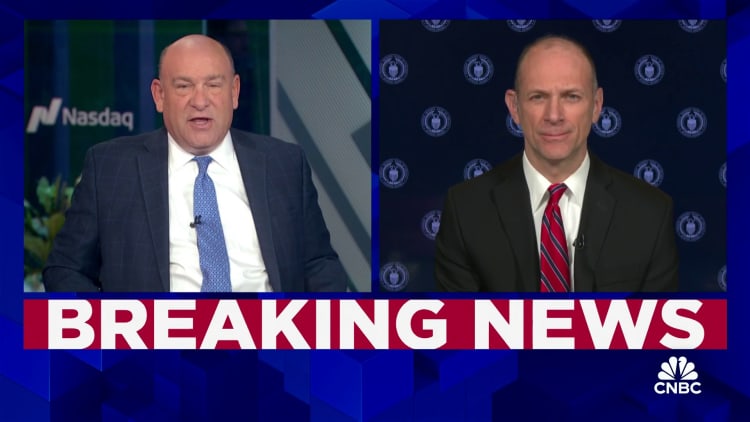
Both data points should garner a lot of attention, particularly the inflation numbers, which have been trending toward the Fed’s 2% goal but aren’t there yet.
“That’s the thing that everybody should be watching to determine what the Fed’s rate path will end up being,” Chicago Fed President Austan Goolsbee said during an interview Friday on CNBC. “It’s not about secret meetings or decisions. It’s fundamentally about the data and what will enable us to become less restrictive if we have clear evidence that we’re on the path to get” inflation back to target.
Lowered rate cut outlook
The releases come amid a market snapback about where the Fed is heading.
As of Friday afternoon, trading in the fed funds futures market equated to virtually no chance the rate-setting Federal Open Market Committee will cut at its Jan. 30-31 meeting, according to CME Group data as indicated through its FedWatch Tool. That’s nothing new, but the odds for a reduction at the March meeting fell to 47.2%, a steep slide from 81% just a week ago.
Along with that, traders have taken one expected cut off the table, reducing the outlook for easing to five quarter percentage point decreases from six previously.
The change in sentiment followed data showing stronger-than-expected 0.6% growth in consumer spending for December and initial jobless claims falling to their lowest weekly level since September 2022. On top of that, several of Goolsbee’s colleagues, including Governor Christopher Waller, New York Fed President John Williams and Atlanta Fed President Raphael Bostic, issued commentary indicating that at the very least they are in no hurry to cut even if the hikes are probably done. Goolsbee is not a voter on the FOMC this year.
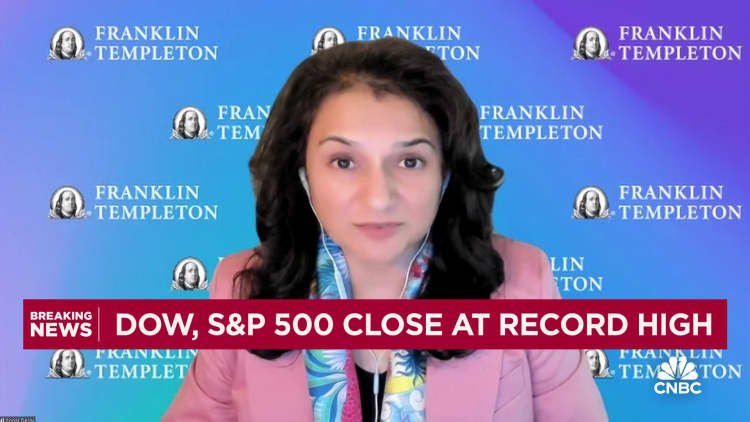
“I don’t like tying my hands, and we still have weeks of data,” Goolsbee said. “Let’s take the long view. If we continue to make surprising progress faster than was forecast on inflation, then we have to take that into account in determining the level of restrictiveness.”
Goolsbee noted that one particular area of focus for him will be housing inflation.
The December consumer price index report indicated that shelter inflation, which accounts for about one-third of the weighting in the CPI, rose 6.2% from a year ago, well ahead of a pace consistent with 2% inflation.
However, other measures tell a different story.
A new Labor Department reading known as the New Tenant Rent Index, indicates a lower path ahead for housing inflation. The index, which measures prices for new leases that tenants sign, showed a 4.6% decline in the fourth quarter of 2023 from a year ago and more than double that quarterly.
Watching the data, and other factors
“In the very near term, we think the inflation data will cooperate with the Fed’s dovish plans,” Citigroup economist Andrew Hollenhorst said in a client note.
However, Citi foresees inflation as stubborn and likely to delay the first cut until at least June.
While it’s unclear how much difference the timing makes, or how important it is if the Fed only cuts four or five times compared with the more ambitious market expectations, market outcomes have seem linked to the expectations for monetary policy.
There are plenty of factors that change the outlook in both directions — a continued rally in the stock market might worry the Fed about more inflation in the pipeline, as could an acceleration in geopolitical tensions and stronger-than-expected economic growth.
“By keeping the potential alive for inflation to turn up, these economic and geopolitical developments could put upward pressure on both short-term rates and long-term yields,” Komal Sri-Kumar, president of Sri-Kumar Global Strategies, said Saturday in his weekly market note.
“Could the Federal Reserve be forced to raise the Federal Funds rate as its next move rather than cut it?” he added. “An intriguing thought. Don’t be surprised if there is more discussion along these lines in coming months.”
Don’t miss these stories from CNBC PRO:
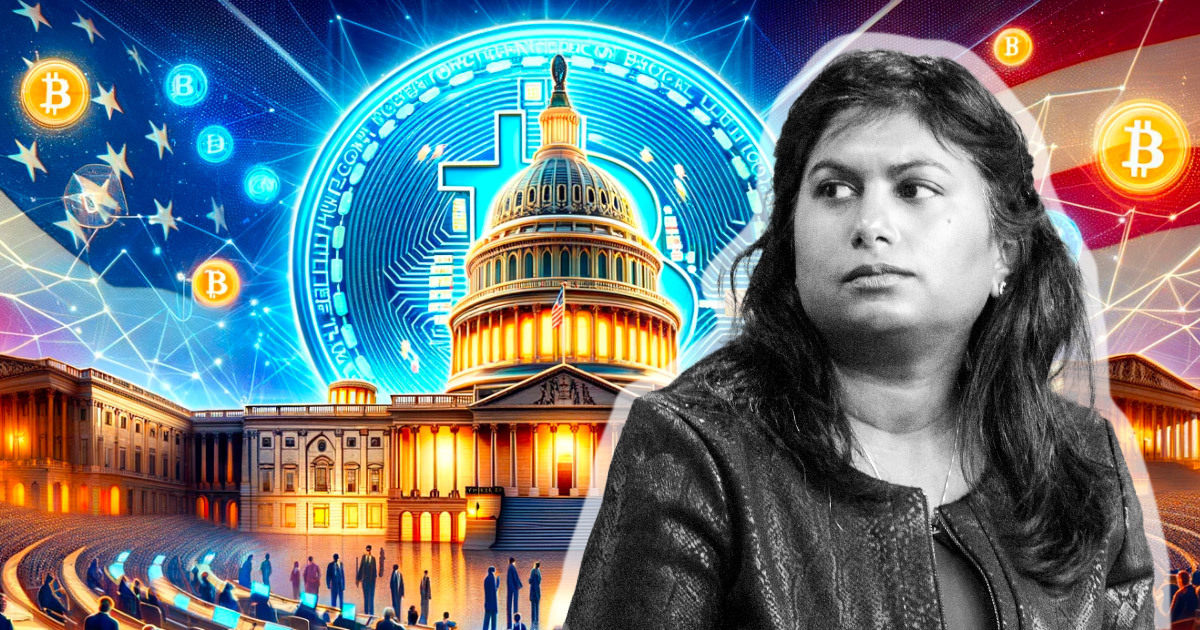
2023 saw an unprecedented wave of regulatory actions around cryptocurrencies around the world, but nowhere was the change more noticeable than in the United States. Preceded by an opening salvo in August 2022, when the Treasury Department applied sanctions to the Ethereum coin mixer Tornado Cash, 2023 saw clampdown after clampdown, from multiple SEC suits against central exchanges, criminal charges against developers, and even a guilty plea from the industry’s most prominent public figurehead.
The message is clear: any lingering doubts about the U.S. government’s willingness to intervene in the industry have been put to rest. Now, as we enter the new year with cries for regulatory action growing louder on both sides, 2024 is poised to be a watershed year in crypto policy—for better or for worse.
To further gauge the state of play, CryptoSlate spoke with Nilmini Rubin, the Chief Policy Officer at Hedera, whose current work places her in a unique position to offer insights. With a career that reaches from the halls of Congress to the West Wing itself, Rubin’s extensive experience in policy-making and technology implementation places her at the confluence of blockchain technology, policy, and global market trends.
Conversations
As a party to a variety of conversations on the Hill, Rubin provided some insight into the concerns lawmakers have, which are many and varied. “Some [policymakers] are just interested in learning about the basic technology,” she says. “Others want to dive into the deepest parts of the technology and the policy implications,” she continues, explaining further that concerns range from national security, business opportunities, environmental implications, and more.
The global perspective, Rubin notes, seems different. “They are looking at it from a very different framework. It’s more [about] what are the benefits generally, and how do we mitigate the risks?” This approach, common outside the U.S., reflects a broader, more holistic perspective on blockchain technology. Policymakers in these regions tend to weigh the overall advantages against potential risks, seeking a balanced view that considers both technological innovation and its societal implications.
Contrastingly, Rubin points out that U.S. policymakers often focus on how blockchain fits within current U.S. law and policy. This inward-looking approach is more about integrating new technology into existing frameworks rather than reevaluating or adapting these frameworks to accommodate new possibilities. Rubin further explains that when discussing blockchain policy with counterparts in Asia, for instance, the conversation often involves looking at how different regions like Europe or the UK have tackled similar issues, indicating a more comparative and globally informed approach.
In explaining why U.S. policymakers might not adopt a similar global perspective, Rubin suggests that it’s largely a matter of focus. “They’re really thinking about the United States. They’re thinking about their constituents,” she says. This constituent-focused approach can sometimes limit the scope of their policy considerations to domestic concerns, potentially overlooking broader global perspectives or innovative approaches adopted elsewhere.
Applications
While many think of the crypto space as a world characterized by high risk and hyperbolic expectations, Rubin stresses that Hedera is working from a position of real-world application, with little interest in its token’s secondary market value. It has so far found special uses in agriculture and carbon tracking, both of which have not only huge markets to serve but also stand to benefit from expanded capacities for eco-conscious business practice.
Rubin highlighted Dovu, a marketplace built on Hedera that allows farmers to issue tokenized carbon credits. This innovation offers a dual benefit: it provides farmers with a new revenue stream by monetizing the carbon sequestered in their soil and contributes to environmental sustainability. The process involves farmers planting crops beyond their usual areas and receiving credits for the additional carbon capture. What sets this system apart is its transparency and accountability, as blockchain technology enables precise tracking of where each carbon offset originates, thus avoiding greenwashing.
Rubin emphasized that while the conversation surrounding these technologies often becomes narrowly focused on the fluctuating values of cryptocurrencies as assets, the real value is in what each asset does and what it is for. Regarding the market price of a crypto asset, Rubin says:
“It’s not about that at all. It’s what what the point of this is to enable businesses to thrive. It’s not about the asset. And so we want to show how people are using the technology. The crypto is just a fuel to power the network.”
She explained that, unlike the Web 2.0 model, which relies heavily on advertisement for funding, blockchain technology (or, in Hedera’s case, hashgraph technology) operates on a different paradigm. It utilizes the smaller fees associated with the exchange of information as a funding mechanism. This approach is not only global in its reach but also necessitates rapid processing, for which cryptocurrency becomes a more practical tool than traditional currencies, especially when considering the limitations of standard banking hours and transaction clearances.
2024 and forward
Looking to the future, Rubin expresses a measured optimism about the progress of blockchain regulation in the U.S. She states, “I am hopeful that something will get through that helps advance regulation of blockchain and cryptocurrency in the U.S.” Her optimism is based on the growing awareness among policymakers and an elevated level of discourse around crypto policy in Washington. She acknowledges, however, that things do not happen easily or quickly in Washington, so her optimism is tempered with caution.
Until then, she and others must keep working to advance the conversation where it counts. The intent, as Rubin outlined, is to illuminate the broader utility and richness of blockchain technology for policymakers. The objective is to ensure that any regulations developed to govern this space are crafted in a way that recognizes and harnesses the technology’s potential to benefit consumers and businesses alike.
“We want policymakers to understand like the richness of the technology, so that any rules that they put in place, enable the technology to benefit consumers. If they only think about it from addressing fraud that had been committed by by bad players, they’re going to potentially throw the baby out with the bathwater. We definitely don’t want that to happen.”
There’s a delicate balance to be struck in regulation – to protect against fraud and misuse by bad actors without stifling the innovative and beneficial aspects of the technology. In a year that has seen its headlines dominated by bad actors — and there has been no shortage of them — Nilmini Rubin and her colleagues are reminding U.S. lawmakers daily not to lose sight of the many wonderful applications of the technology when the bad actors are swept away.
Stablecoin issuing company Tether has announced a new security policy aimed at protecting the crypto ecosystem from bad actors. In addition, the USDT issuer is looking to enhance its cooperation and relationship with law enforcement agencies.
Tether Freezes 41 New Wallets Following New Security Policy
In a blog post on December 9, Tether stated it would be introducing a voluntary wallet-freezing initiative designed to counter the transactions associated with Sanctioned Persons on the Office of Foreign Assets Control (OFAC) Specially Designated Nationals (SDN) List.
According to Tether, the company currently has a wallet-freezing policy, but it is only applicable to wallets on its platform. Moving forward, the stablecoin issuer now offers its sanctions control on the secondary market, as it aims to improve its collaboration with governmental agencies in ensuring the safe use of stablecoins.
Interestingly, Tether’s latest policy is in direct opposition to its stance in 2022 when it stated it would not willingly restrict sanctioned Tornado cash addresses, barring a direct order from security agencies. With its announcement, the stablecoin issuer has now begun implementation of its new policy and ordered a wallet-freeze of all 41 wallets associated with persons and companies on the OFAC-SDN list.
Commenting on this development, Pablo Ardonio has expressed much excitement towards user safety and forming stronger ties with regulators worldwide.
He said:
This strategic decision aligns with our unwavering commitment to maintaining the highest standards of safety for our global ecosystem and expanding our close working relationship with global law enforcement and regulators. By executing voluntary wallet address freezing of new additions to the SDN List and freezing previously added addresses, we will be able to further strengthen the positive usage of stablecoin technology and promote a safer stablecoin ecosystem for all users.
Meanwhile, some crypto enthusiasts have welcomed this development as they believe it could exert some positive effect on stablecoin adoption in terms of regulations and general usage.
Breaking: @Tether_to public statement to comply with regulators demand to have freezable wallets for security. This is bullish meaning @Tether_to and the US government are working together, this will bring in the US Stable Coin Act and global adoption.#Tether#USDT… pic.twitter.com/E0eCC1skxf
— MartyParty (@martypartymusic) December 9, 2023
Mystery USDT Transaction
In other news, the Tether Treasury transferred $60 million worth of USDT to a “mysterious fund/institution” on December 8.
This development was revealed by blockchain analytics firm Lookonchain, which also stated that Tether had transferred a total of $1.76 billion USDT to this fund/institution since October 20, which has been further dispersed to other exchanges.
Being the issuer of the world’s largest stablecoin, large-scale transactions of this size are bound to draw attention to Tether due to its importance in the crypto ecosystem.
At the time of writing, USDT maintains its spectacular performance in 2023, having attained a $90 billion market cap value. This value represents over 70% dominance in the stablecoin market.
Total crypto market cap valued at $1.592 trillion on the daily chart | Source: TOTAL chart on Tradingview.com
Featured image from CNBC, chart from Tradingview
Why Fed Policy Will Push Bitcoin and Gold to New Highs after Spot BTC ETF Approval
Novogratz is not the only expert who expects Bitcoin price to skyrocket soon. One of the main reasons is that long-term holders are not selling off their positions
According to Michael Novogratz, founder of digital asset management company Galaxy Digital, things may soon change for other stores of value like gold and Bitcoin (BTC) as the United States Federal Reserve changes course. In a Bloomberg interview, Novogratz shared optimism for these assets based on expectations that the Fed will become less aggressive with its policies.
Since it looks like the Fed is shifting from tough tightening policies, Novogratz believes the US central bank will spark an increased willingness among investors to take on more risks across various markets. Also, the US dollar has already shown declines as traders anticipate future Fed rate cuts in prices.
Economically, Novogratz sees meaningful slowing in the US early next year, clearing the way for Fed rate cuts by mid-2024. Recent dollar weakness could show a long-term change as well. Despite the shifting situation, Novogratz stays strongly positive on Bitcoin (BTC), especially if Wall Street giants like BlackRock or Fidelity join the physically backed ETF train.
For Bitcoin, Novogratz notes some possible supports, including physically-backed ETF approvals, less selling activity from long-term holders, and reduced creation of new coins which will be introduced by the upcoming halving event next year. Under this situation, he believes Bitcoin could go beyond its old all-time highs next year.
Novogratz is not the only expert who expects Bitcoin prices to skyrocket soon. One of the popular reasons is that the long-term holder is not selling off their positions for the belief that the crypto will soon experience a bull run and the expectation of more bullish price potential, especially because the coin has not reached its full potential. His belief that the approval of the physically back ETFs will also drive the price up is agreed upon by many analysts, especially because the acceptance is expected to drive hundreds of billions of dollars into the BTC market, seeing that major financial giants like Black Rock and Fidelity are also involved.
How Other Currencies Could Fare, According to Michael Novogratz
Novogratz’s negative forecast for the US dollar is also based on weaker US growth and interest rate direction. However, he sees Euro, Australian dollar, and Brazilian real doing well if the dollar remains weak. The expert also sees upside potential for gold if prices stay above $2,000 for some weeks. Additionally, silver could surge even higher as shortages stoke demand. However, Novogratz maintains a gloomy outlook for China’s yuan, given disappointing economic data.
Commenting on the crypto sector overall, Novogratz said most fraudulent projects were removed during the 2022 decline as markets and regulators effectively eliminated bad actors. They are also ensuring existing projects are fully compliant with regulations and any wrongdoing is punished, as evident in the recent Binance and its CEO’s cases. The way regulators and relevant government agencies have handled cases of fraud within the industry has also been highly commendable.
next
Bitcoin News, Blockchain News, Cryptocurrency News, Market News, News
You have successfully joined our subscriber list.
Fed’s Daly says it makes sense to wait on interest-rate policy given all the uncertainty
The Federal Reserve should wait and see how the economy develops given the high uncertainty surrounding the outlook for the U.S. economy, San Francisco Fed President Mary Daly said Friday.
“When we know where we’re going and it’s important to get there, moving aggressively makes sense,” Daily said in a speech to a banking conference in Frankfurt. But she noted that sometimes a “different type of boldness is required: the boldness to wait.”
Daly added: “When uncertainty is high and the risks to our objectives more balanced, we need to practice gradualism. That means the Fed is saying, We don’t know yet.”
Traders in derivative markets now expect the Fed to remain on hold until next May and that the next move will be to cut rates. The central bank last raised its benchmark rate to between 5.25%-5.5% in July.
Daly said Fed officials are not certain whether inflation is on track to return to 2%. She said the central bank is also not sure whether all the negative effects from past tightening have hit the economy.
“And we are uncertain about whether the dynamics we observe today are cyclical remnants of the post-pandemic recovery or indicators of structural shifts and a new normal for the national and global economy,” Daly added.
The yield on the 10-year Treasury note
BX:TMUBMUSD10Y
rose slightly to 4.44% in early trading on Friday.
State Dept. official Josh Paul quits over ‘blind support’ Israel policy
““The fact is, blind support for one side is destructive in the long term to the interests of the people on both sides. I fear we are repeating the same mistakes we have made in these past decades, and I decline to be a part of it for longer””
— Josh Paul, director at the U.S. State Department
That was Josh Paul, an 11-year veteran of the State Department, explaining his decision to resign Wednesday from his post as Director of Congressional & Public Affairs, Bureau of Political-Military Affairs, in a post on his LinkedIn account.
“Let me be clear: Hamas’ attack on Israel was not just a monstrosity; it was a monstrosity of monstrosities,” said Paul, who was responsible for “shaping and implementing an holistic communications strategy in support of U.S. security assistance, arms transfers, and global defense partnerships,” according to his account.
He said while further escalations by Iran-linked groups would exploit an already tragic situation, he believes “the response Israel is taking, and with it the American support both for that response, and for the status quo of the occupation, will only lead to more and deeper suffering for both the Israeli and the Palestinian people — and is not in the long-term American interest.”
Josh described the U.S. response as “an impulsive reaction built on confirmation bias, political convenience, intellectual bankruptcy and bureaucratic inertia,” as well as deeply disappointing and not surprising. He said that both Palestinians and Israelis have a right to flourish, with kidnapping children and taking people at gunpoint from their villages as Hamas did in its shocking attack, an “enemy to that desire.”
“And collective punishment is an enemy to that desire, whether it involves demolishing one home, or one thousand; as too is ethnic cleansing, as too is occupation, as too is apartheid,” said Paul, adding that third parties like the U.S. have a duty to help those “caught in the middle, and that of generations to come.”
In the two-page post, Paul said that given his role is “solidly in the arms transfer space,” he would be rushing more arms to the Israeli side of the conflict that he sees as “shortsighted, destructive, unjust and contradictory,” to American values.
Paul’s post drew over 400 comments.
More than 1,400 people in Israel have died since Hamas crossed into Israeli territory nearly two weeks ago, with roughly 200 people believed to have been kidnapped. That has led to a Israeli seize of Gaza — the country’s health ministry calculates 3,478 people have died, with more than 12,000 wounded.
An explosion at a hospital in Gaza City on Tuesday is believed to have killed hundreds, sparking international outrage and protests. Both the Israeli military and Hamas have blamed each other for that attack.
In Israel on Wednesday, President President Biden pledged support for Israel, telling Prime Minister Benjamin Netanyahu that the U.S. doesn’t believe his country was responsible for the hospital blast. Israel said Wednesday that it would allow in humanitarian aid from Egypt into the Gaza Strip.
Opinion: Israel-Hamas war threatens the global tech sector’s growth and innovation

On Sept. 16, Google updated the description of its helpful content system. The system is designed to help website administrators create content that will perform well on Google’s search engine.
Google doesn’t disclose all the means and ways it employs to “rank” sites, as this is at the heart of its business model and precious intellectual property, but it does provide tips on what should be in there and what shouldn’t.
Until Sept. 16, one of the factors Google focussed on was who wrote the content. It gave greater weighting to sites it believed were written by real humans in an effort to elevate higher quality, human-written content from that which is most likely written using an artificial intelligence (AI) tool such as ChatGPT.
It emphasized this point in its description of the helpful content system: “Google Search’s helpful content system generates a signal used by our automated ranking systems to better ensure people see original, helpful content written by people, for people, in search results.”
However, in the latest version, eagle-eyed readers spotted a subtle change:
“Google Search’s helpful content system generates a signal used by our automated ranking systems to better ensure people see original, helpful content created for people in search results.”
It seems content written by people is no longer a concern for Google, and this was then confirmed by a Google spokesperson, who told Gizmodo: “This edit was a small change […] to better align it with our guidance on AI-generated content on Search. Search is most concerned with the quality of content we rank vs. how it was produced. If content is produced solely for ranking purposes (whether via humans or automation), that would violate our spam policies, and we’d address it on Search as we’ve successfully done with mass-produced content for years.”
This, of course, raises several interesting questions: how is Google defining quality? And how will the reader know the difference between a human-generated article and one by a machine, and will they care?
Mike Bainbridge, whose project Don’t Believe The Truth looks into the issue of verifiability and legitimacy on the web, told Cointelegraph:
“This policy change is staggering, to be frank. To wash their hands of something so fundamental is breathtaking. It opens the floodgates to a wave of unchecked, unsourced information sweeping through the internet.”
The truth vs. AI
As far as quality goes, a few minutes of research online shows what sort of guidelines Google uses to define quality. Factors include article length, the number of included images and sub-headings, spelling, grammar, etc.
It also delves deeper and looks at how much content a site produces and how frequently to get an idea of how “serious” the website is. And that works pretty well. Of course, what it is not doing is actually reading what is written on the page and assessing that for style, structure and accuracy.
When ChatGPT broke onto the scene close to a year ago, the talk was centered around its ability to create beautiful and, above all, convincing text with virtually no facts.
Earlier in 2023, a law firm in the United States was fined for filing a lawsuit containing references to cases and legislation that simply do not exist. A keen lawyer had merely asked ChatGPT to create a strongly worded filing about the case, and it did, citing precedents and events that it conjured up out of thin air. Such is the power of the AI software that, to the untrained eye, the texts it produces seem entirely genuine.
So what can a reader do to know that a human wrote the information they have found or the article they are reading, and if it’s even accurate? Tools are available for checking such things, but how they work and how accurate they are is shrouded in mystery. Furthermore, the average web user is unlikely to verify everything they read online.
To date, there was almost blind faith that what appeared on the screen was real, like text in a book. That someone somewhere was fact-checking all the content, ensuring its legitimacy. And even if it wasn’t widely known, Google was doing that for society, too, but not anymore.
In that vein, blind faith already existed that Google was good enough at detecting what is real and not and filtering it accordingly, but who can say how good it is at doing that? Maybe a large quantity of the content being consumed already is AI-generated.
Given AI’s constant improvements, it is likely that the quantity is going to increase, potentially blurring the lines and making it nearly impossible to differentiate one from another.
Bainbridge added: “The trajectory the internet is on is a perilous one — a free-for-all where the keyboard will really become mightier than the sword. Head up to the attic and dust off the encyclopedias; they are going to come in handy!”
Google did not respond to Cointelegraph’s request for comment by publication.
Collect this article as an NFT to preserve this moment in history and show your support for independent journalism in the crypto space.
Anthropic’s ‘responsible scaling’ policy introduces outline for safe AI development
Anthropic, the artificial intelligence research company behind the chatbot Claude, unveiled a comprehensive Responsible Scaling Policy (RSP) this week aimed at mitigating the anticipated risks associated with increasingly capable AI systems.
Borrowing from the US government’s biosafety level standards, the RSP introduces an AI Safety Levels (ASL) framework. This system sets safety, security, and operational standards corresponding to each model’s catastrophic risk potential. Higher ASL standards would require stringent safety demonstrations, with ASL-1 involving systems with no meaningful catastrophic risk, while ASL-4 and above would address systems far from current capabilities.
The ASL system is intended to incentivize progress in safety measures by temporarily halting the training of more powerful models if AI scaling surpasses their safety procedures. This measured approach aligns with the broader international call for responsible AI development and use, a sentiment echoed by U.S. President Joe Biden in a recent address to the United Nations.
Anthropic’s RSP seeks to assure existing users that these measures will not disrupt the availability of their products. Drawing parallels with pre-market testing and safety design practices in the automotive and aviation industries, they aim to rigorously establish the safety of a product before its release.
While this policy has been approved by Anthropic’s board, any changes must be ratified by the board following consultations with the Long Term Benefit Trust, which is set to balance public interests with Anthropic’s stockholders. The Trust comprises five Trustees experienced in AI safety, national security, public policy, and social enterprise.
Ahead of the game
Throughout 2023, the discourse around artificial intelligence (AI) regulation has been significantly amplified across the globe, signaling that most nations are just starting to grapple with the issue. AI regulation was brought to the forefront during a Senate hearing in May when OpenAI CEO Sam Altman called for increased government oversight, paralleling the global regulation of nuclear weapons.
Outside of the U.S., the U.K. government proposed objectives for their AI Safety Summit in November, aiming to build international consensus on AI safety. Meanwhile, in the European Union, tech companies lobbied for open-source support in the EU’s upcoming AI regulations.
China also initiated its first-of-its-kind generative AI regulations, stipulating that generative AI services respect the values of socialism and put in adequate safeguards. These regulatory attempts underscore a broader trend, suggesting that nations are just beginning to understand and address the complexities of regulating AI.
My work offers a hybrid life-insurance and long-term-care policy. Should I sign up?
Got a question about the mechanics of investing, how it fits into your overall financial plan, and what strategies can help you make the most out of your money? You can write me at beth.pinsker@marketwatch.com.
I keep getting these emails from my company about a new benefit they are offering that is a combination of life insurance and long-term-care insurance. I really want to get long-term-care insurance, but I don’t know if this is a good deal or not. There’s a deadline on this offer, which makes it seem weird to me. It’s not even our open enrollment period. Why do I have to decide so fast about something so important? I didn’t feel like I could ask somebody at my own company for objective advice, but I don’t know who to ask otherwise. What should I do?
N.C. employee
Dear N.C. employee,
You’re not the only one asking this question right now. The number of U.S. companies offering a voluntary benefit that combines life insurance with long-term-care insurance has skyrocketed in the past few years. While there’s no official tally of the offers out there, “our activity has gone up 35% this year alone,” says Dan Schmid, vice president of sales for Trustmark Voluntary Benefits, an insurance company that offers hybrid policies.
A variety of market forces have led the insurance industry to this point, which sounds arcane, but it matters for your decision tree. To decide whether this is a good deal, you have to consider whether a better offer might come along.
Better offers were certainly available years ago, when many employers offered group policies for stand-alone long-term care with generous benefits, and you could also more readily get coverage as an individual. But the market for this kind of policy imploded because costs were too great for the insurance companies, especially in a low-interest-rate environment.
In the past few years, the COVID-19 pandemic shifted people’s thinking about future healthcare costs, and legislation is pending across the country — and is already in force in Washington state — to mandate that companies provide this coverage in order to alleviate the burden on Medicare and Medicaid. On top of all that, the economy has changed, and now interest rates are high, along with inflation, which is changing the pricing dynamic.
To meet demand, insurance companies came up with today’s hybrid offerings. For the employer-sponsored plans, you can typically get coverage up to certain limits without passing any health checks — what’s known as guaranteed-issue in the business. Your spouse or other dependents who qualify will most likely have to go through underwriting, though.
You pay the premiums out of your paycheck, and you can take the policy with you after you leave the job, so it can stay in force for your lifetime. You build up value as you go. If you should have a long-term-care need, the policy will pay out a monthly amount for a specific time period, like three or five years. Whatever is left at your death goes to your heirs.
Policies range in price and vary by the age of the enrolled person, but a typical one would cost about $3,700 per year for a woman in her early 50s, with premiums rising over the life of the plan or if you choose to add to the death benefit over time. That would get you up to a $400,000 long-term care benefit, paid at $8,000 a month for 50 months, and a $200,000 death benefit.
Here’s the big catch: There’s typically no inflation adjustment for the benefit amount. The amount needed for long-term care today is likely to be $400,000 for the typical married couple, notes retirement expert Wade Pfau, who calculated a case study for the upcoming edition of his Retirement Planning Guidebook.
That $8,000 monthly benefit would seem to meet that need now, but what about in 30 years, when that 50-something woman is in her 80s? The benefit dollar amount stays the same, but inflation could turn her need into $725,000 with inflation of just 2%. And to be honest, even today, $8,000 is unlikely to fully cover a month in an assisted-living facility, which runs more like $12,000.
“Inflation is a big deal, so you just have to take that into consideration,” says Howard Sharfman, senior managing director at NFP Insurance Solutions, a brokerage.
That means if you think your eventual need would be $20,000 a month, you should purchase enough coverage to get there. But to get that bigger policy — which also would likely come with a six-month exclusion for pre-existing conditions — you will exceed the guaranteed-issue threshold and would have to pass the medical tests. And in any case, you probably wouldn’t even find a policy that offers that level of benefit.
Should you take what you can get?
The hard-sell pitch for hybrid long-term-care policies is literally this: Something is better than nothing. And the decision is on a deadline because companies have found that motivates people to act.
It could very well be true that something is better than nothing.
“For some people, it’s going to be outstanding, because they’ll put in money and never need the benefit and their heirs will get a death benefit,” says Jesse Slome, director of the American Association for Long-Term Care Insurance. “For a more significant number of people who buy it and need long-term care, the benefit will be sufficient. They’ll make do and manage with that.”
The alternative is self-funding, which makes sense mathematically but perhaps not behaviorally. Take the pricing example of the 50-year-old paying $3,700 a year for 30 years, not counting premium increases. If you took that amount and invested it yearly, you’d have $153,000 after 20 years at 7% returns. That’s nearly the policy life insurance benefit. Add another 10 years to that — presuming you wouldn’t need long-term care until you hit 80 — and you’d have a nest egg of nearly $350,000.
“If you invested that amount in a diversified portfolio, you could probably expect to get a higher return than through an insurance product,” Pfau says.
The truth, however, is that people may not do that, and so the death benefit in a hybrid policy acts as a kind of forced savings and investment plan, where you get back what you put in, plus a little interest.
“There can be some psychological benefits to having some coverage,” Pfau notes.
Will something better come along?
It’s not hard to imagine that the industry might find other ways of delivering a long-term-care benefit to consumers who desperately need it, without bankrupting the companies that provide the insurance.
Already some companies are experimenting with different kinds of hybrid offerings — like John Hancock, which also bundles wellness programs into its policies.
And people are beginning to think differently about why you get long-term-care insurance — it’s less about a return on investment and more about protecting the next generation. “Insurance works best when it’s low probability, low cost. With long-term care, it’s not a low probability. There’s a good shot you’ll use the benefits, which makes it very expensive to get,” says Pfau.
So should you take your company’s offering? At the end of the day, it only matters that you understand the need that’s coming and try to find a way to save for it, whether it’s through an insurance policy or by saving on your own. If you feel too rushed, then wait and see what comes next.


